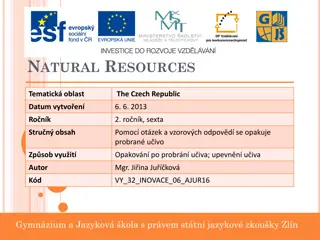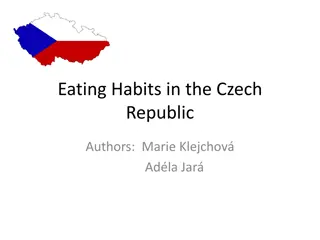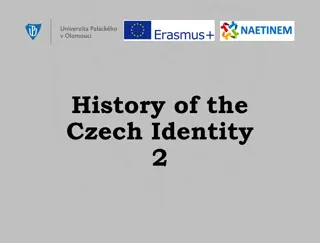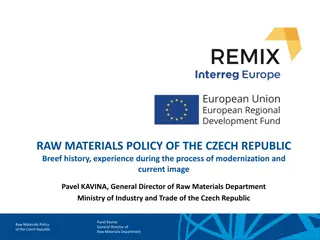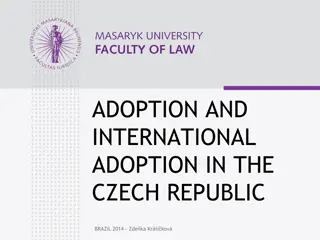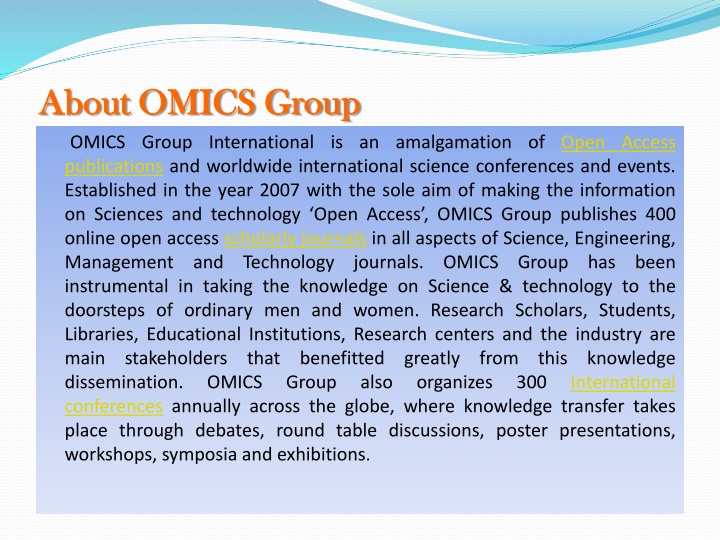
OMICS Group: Science Journals, Conferences, and Knowledge Sharing
OMICS Group International, founded in 2007, is dedicated to promoting open access to science and technology information through 400 online scholarly journals and over 300 global conferences annually. Their events facilitate knowledge transfer through various forums. The company organizes conferences in diverse fields and has significant outreach among research scholars, students, and industry professionals.
Download Presentation

Please find below an Image/Link to download the presentation.
The content on the website is provided AS IS for your information and personal use only. It may not be sold, licensed, or shared on other websites without obtaining consent from the author. If you encounter any issues during the download, it is possible that the publisher has removed the file from their server.
You are allowed to download the files provided on this website for personal or commercial use, subject to the condition that they are used lawfully. All files are the property of their respective owners.
The content on the website is provided AS IS for your information and personal use only. It may not be sold, licensed, or shared on other websites without obtaining consent from the author.
E N D
Presentation Transcript
About OMICS Group About OMICS Group OMICS Group International is an amalgamation of Open Access publications and worldwide international science conferences and events. Established in the year 2007 with the sole aim of making the information on Sciences and technology Open Access , OMICS Group publishes 400 online open access scholarly journals in all aspects of Science, Engineering, Management and Technology journals. instrumental in taking the knowledge on Science & technology to the doorsteps of ordinary men and women. Research Scholars, Students, Libraries, Educational Institutions, Research centers and the industry are main stakeholders that benefitted dissemination. OMICS Group also conferences annually across the globe, where knowledge transfer takes place through debates, round table discussions, poster presentations, workshops, symposia and exhibitions. OMICS Group has been greatly organizes from this knowledge International 300
About OMICS Group Conferences About OMICS Group Conferences OMICS Group International is a pioneer and leading science event organizer, which publishes around 400 open access journals and conducts over 300 Medical, Clinical, Engineering, Life Sciences, Phrama scientific conferences all over the globe annually with the support of more than 1000 scientific associations and 30,000 editorial board members and 3.5 million followers to its credit. OMICS Group has organized 500 conferences, workshops and national symposiums across the major cities including San Francisco, Las Vegas, San Antonio, Omaha, Orlando, Philadelphia, Baltimore, United Kingdom, Valencia, Dubai, Beijing, Hyderabad, Bengaluru and Mumbai. Raleigh, Santa Clara, Chicago,
The cellular basis of protective immunity against experimental infection caused by Francisella tularensis Kubelkova K., Orlikova A., Krocova Z., Pejchal J., Macela A., Stulik J. Faculty of Military Health Sciences, University of Defense, 500 01 Hradec Kralove, Czech Republic 3
Francisella tularensis Francisellae facultative intracellular bacterial pathogens Small, nonmotile, obligate anaerobe One of the most infectious bacterial agens (10 CFU) Francisella proliferates inside macrophages, neutrophils, dendritic cells and hepatocytes Geographic distribution of four existing Francisella tularensis subtypes (holarctica Type B, tularensis Type A1 and A2, mediasiatica, novicida) Tularemia Zoonotic infection Vectors mainly ticks and mosquitoes Broad spectrum of clinical manifestations with dominant symptoms granulomas and secondary atypical pneumonia Treatment ATB (Gen, Tet) The cellular basis of protective immunity against experimental infection caused by Centre of Advanced Studies, Faculty of Military Health Sciences, University of Defence, 500 01 Hradec Kralove, Czech Republic Francisella tularensis 4
Kubelkova K. and Macela A.: Putting Jigsaw Together - A Brief Insight Into the Tularemia, Open Life Sciences, 2015, Centre of Advanced Studies, Faculty of Military Health Sciences, University of Defence, 500 01 Hradec Kralove, Czech Republic Ready to publish. 5
B cell involvement B cells and antibodies are necessary for mice to develop their natural resistance to primary and secondary LVS infections .The role of antibodies in the protection against intracellular pathogen F. tularensis still remains poorly understood ! Extracellular phase in the host, which makes it accessible to humoral immune responses Ab responses containing both Th-1 and Th-2 antibody isotypes are detectable as early as 3 days following i.d. infection Confer early as well as long term immunity Immune response against LPS (as a major protective antigen) No naturally B cell-deficient murine strain has been identified yet Serum Ab against bacterial proteins FopA, OmpA, DsbA, GroEL, KatG etc. Centre of Advanced Studies, Faculty of Military Health Sciences, University of Defence, 500 01 Hradec Kralove, Czech Republic 6
The role of antibodies in protective immune response Traditional view Antibodies have little (if any) protective role against tularemia Late 1970ies Antibodies can confer protection against attenuated Francisella tularensis strains and can confer some degree of protection against virulent strains of holarctica subtype /Macela A.: Thesis, 1980. Late 1990ies B-cells but not circulating antibodies are indispensable in protective immunity against tularemia /Elkins K.et al: Infect Immun.,1999. New millennium: Passive transfer of immunity protects against the same subtype Passive transfer of immunity against tularemia is possible Antibody-dependent cell-mediated cytotoxicity (ADCC) / Fulop M. et al: Vaccine, 2001. , Stenmark S. et al: Microb Pathog., 2003., Sanapala et al. 2012, Kubelkova K. et al. Microbial Pathogen, 2012 Centre of Advanced Studies, Faculty of Military Health Sciences, University of Defence, 500 01 Hradec Kralove, Czech Republic 7
The role of antibodies in protective immune response Balb/c mice Cobalt 60 Dose of 4 Gy Centre of Advanced Studies, Faculty of Military Health Sciences, University of Defence, 500 01 Hradec Kralove, Czech Republic 8
Fenotypization of spleen cells of immunosuprimmised Balb/c mice CD3+ CD8+ T cells 104 104 R7 R8 R7 R8 PE-Cy7 Log Comp PE-Cy7 Log Comp 103 103 102 102 R9 R10 101 101 R9 R10 100 100 100 101 102 103 104 100 101 102 103 104 PE Log Comp PE Log Comp Obr. .3: CD3+CD8+T lymfocyty
Passive transfer of antibodies protects irradiated mice against F. tularensis holarctica LVS infection Francisella tularensis LVS (1.3 x 102 live microbes, s.c.) Co60 (4 Gy) Immune or normal sera (0.2 ml serum, i.p.) 48 hrs 2 hrs 21 days Centre of Advanced Studies, Faculty of Military Health Sciences, University of Defence, 500 01 Hradec Kralove, Czech Republic 10
Passive transfer of immunity protects irradiated mice against primary as well as secondary F. tularensis infection Francisella tularensis LVS (1.3 x 102 live microbes, s.c.) Co60 (4 Gy) Immune or normal sera (0.2 ml serum, i.p.) 3 days 2 hrs 22 days 21 days Francisella tularensis SchuS4 (1.2 x 102 live microbes, s.c.) Centre of Advanced Studies, Faculty of Military Health Sciences, University of Defence, 500 01 Hradec Kralove, Czech Republic 11
Live microbes induce protective Abs in immunosuprised individuals Number of mice 10 Irradiation Interval of immunization 2 hod. before infection 2 hod. before infection 2 hod. before infection 2 hod. before infection 2 hod. before infection 2 hod. before infection 2 hod. before infection Route immun. i.p. Immunization [200ul] Ab 4Gy+LVS Infection Dose LVS [200ul] 106 bb/mouse Route infect. s.c. 1KL - F. tularensis LVS 2KL 10 - i.p. Ab 4Gy+LVS 107 bb/mouse s.c. F. tularensis LVS 3KL 10 - i.p. Ab 4Gy+LVS 108 bb/mouse s.c. F. tularensis LVS 4KL 10 - i.p. Ab 4Gy+LVS 109 bb/mouse s.c. F. tularensis LVS 5KL 10 - i.p. PBS 107 bb/mouse s.c. F. tularensis LVS 6KL 10 - i.p. PBS 108 bb/mouse s.c. F. tularensis LVS 7KL 10 - i.p. PBS 109 bb/mouse s.c. F. tularensis LVS 100 106LVS, Ab 2h 107LVS, Ab 2h 108 LVS, Ab 2h 109 LVS, Ab 2h 80 Percent survival 60 40 107 LVS, PBS 108 LVS, PBS 109 LVS, PBS 20 0 0 3 6 9 12 15 18 21 Time interval
Live microbes induce protective Abs in immunosuprised individuals Number of mice Immunization [200ul] Interval of immunization 2 hod. before infection Route/ immun. Irradiation Infection Dose LVS [200ul] Route/infect. 1B 4 Gy 102 CFU/mouse 10 Ab 4Gy+LVS i.p. F. tularensis LVS s.c. 103CFU/mouse 2 hod. before infection 2B 4 Gy 10 Ab 4Gy+LVS i.p. F. tularensis LVS s.c. 2 hod. before infection 3B 4 Gy 104CFU/mouse 10 Ab 4Gy+LVS i.p. F. tularensis LVS s.c. 2 hod. before infection 4B 4 Gy 102 CFU/mouse 10 PBS i.p. F. tularensis LVS s.c. 102 CFU/mouse 2 hod. before infection F. tularensis LVS 5B 4 Gy 10 PBS i.p. s.c. 100 102LVS, Ab 2h 103LVS, Ab 2h 104LVS, Ab 2h More efficient protection - using Ab 4Gy+LVS in irradiated animals 80 Percent survival 60 102 LVS, PBS 103 LVS, PBS 40 20 0 0 3 6 9 12 15 18 21 Time interval
Live microbes induce protective Abs in immunosuprised individuals Number of mice Route/immu n. Gy Immunization Time Infection Route/inf. Dose LVS [200ul] 2 hod. before infection F. tularensis LVS 1A 108 CFU/mouse 5 - Ab 4Gy+LVS i.p. s.c. 2 hod. before infection F. tularensis LVS s.c. 2A 109CFU/mouse 5 - Ab 4Gy+LVS i.p. 2 hod. before infection F. tularensis LVS s.c. 3A 103 CFU/mouse 5 4 Gy Ab 4Gy+LVS i.p. 2 hod. before infection F. tularensis LVS s.c. 4A 104 CFU/mouse 5 4 Gy Ab 4Gy+LVS i.p. 2 hod. before infection F. tularensis LVS s.c. 5A 101 CFU/mouse 5 4 Gy PBS i.p. Secondary infection with hypervirulent F. tularensis SchuS4 strain Number of mice Infection Dose SchuS4 [200ul] Protection Route of infection 1A 102 CFU/my 5 F. tularensis SchuS4 100% s.c. 2A 102 CFU/my 5 F. tularensis SchuS4 100% s.c. 3A 102 CFU/my 5 F. tularensis SchuS4 100 % s.c. 4A 102 CFU/my 5 F. tularensis SchuS4 100 % s.c. 5A 102 CFU/my 5 F. tularensis SchuS4 0 % s.c.
Cytokine profile of immunocompromised mice The description of cytokine changes as a factor of importance during Francisella infection in na ve and immunocompromised mice ELISA kits (Invitrogen) IL-1 , IL-4, IL-6, TNF- , IFN- Passive transfer of immunity rather normalize the cytokine levels Dominant disproportion exists in the levels of IFN- in blood and tissue homogenates, which suggests the high consumption of this cytokine in the sites of production Centre of Advanced Studies, Faculty of Military Health Sciences, University of Defence, 500 01 Hradec Kralove, Czech Republic 15
Identification of immunoreactive Francisella proteins Software v. 3.6 GPS Explorer (Applied Biosystems), which integrates the Mascot search algorithm against F. tularensis LVS genome databases http://www.ncbi.nlm.nih.gov/COG/old/xogn itor.html http://www.cbs.dtu.dk/services/SignalP http://www.psort.org/psortb/ Centre of Advanced Studies, Faculty of Military Health Sciences, University of Defence, 500 01 Hradec Kralove, Czech Republic 16
Identification of immunoreactive Francisella proteins Signal transduction mechanisms T- Cell division and chromosome partitioning D- Transcription K- DNA replication, recombination and repair L- Secondary metabolites biosynthesis, transport and catabolism Q- translation, ribosomal structure and biogenesis J- General function prediction only R- aminoacid transport and metabolism E- No related COG coenzyme metabolism H- cell envelope biogenesis, outer membrane M- function unknown S- Nucleotide transport and metabolism F- inorganic ion transport and metabolism P- energy production and conversion C- lipid metabolism I- posttranslation modification, protein turnover, chaperones O- carbohydrate transport and metabolism G- http://www.ncbi.nlm.nih.gov/COG/old/xognitor.html Centre of Advanced Studies, Faculty of Military Health Sciences, University of Defence, 500 01 Hradec Kralove, Czech Republic 17
Conserved hypothetical proteins: FTT0086 FTT0848 FTT0655
The result applications Changing the vaccine strategy Important role of circulating antibodies during the interaction of F. tularensis with host immunoregulatory system Passively protected mice were also able to survive primary LVS and the subsequent challenge with the hypervirulent strain F. tularensis SchuS4 Functional passive immunization protocol for na ve, as well as immunocompromised animals Cytokine production of immunocompromised mice has been characterized as a part the host response to Francisella infection Combination of passive transfer of antibodies and subsequent active immunization represents the safety way to protective immunity against tularemia New immunoreactive proteins monoclonal Abs Centre of Advanced Studies, Faculty of Military Health Sciences, University of Defence, 500 01 Hradec Kralove, Czech Republic 19
With thanks to colleagues and collaborators UNIVERSITY OF DEFENCE Macela Ales Stulik Jiri Krocova Zuzana Safarova Maria Zakova Jitka Kubelkova K., Krocova Z., Balonova L., Stulik J., Macela A.: Specific antibodies protect gamma-irradiated mice against Francisella tularensis strain 15 and live vaccine strain (LVS) infection. Microbial Pathogenesis, 2012, 53, 259-268. Elkins Karen DePascalis Roberto FDA, CBER Kurtz Sherry Kubelkova K., Krocova Z., Plzakova L., Macela A.: The Role of B cells in Intracellular Bacterial Pathogen Infection, B cells: Molecular Biology, Developmental Origin and Impact on the Immune Syst m. 2013, ISBN: 978-1-62808-541-9, p.1-44. Plzakova L., Kubelkova K., Krocova Z., Zarybnicka L., Sinkorova Z., Macela A.: B cell subsets are activated and produce cytokines in the course of early phases of Francisella tularensis LVS infection. Microbial Pathogenesis, 2014, http://dx.doi.org/10.1016/j.micpath.2014.08.009. Kubelkova K. and Macela A.: Putting Jigsaw Together - A Brief Insight Into the Tularemia, Open Life Sciences, 2015, Ready to publish. This work was supported by the Grant Long-term organization plan 1011 received from the Czech Ministry of Education, Youth and Sports and by Grant No. P302/11/1631 from the Czech Science Foundation. Centre of Advanced Studies, Faculty of Military Health Sciences, University of Defence, 500 01 Hradec Kralove, Czech Republic 20
Let Us Meet Again Let Us Meet Again We welcome you all to our future conferences of OMICS Group International Please Visit: www.omicsgroup.com www.conferenceseries.com















